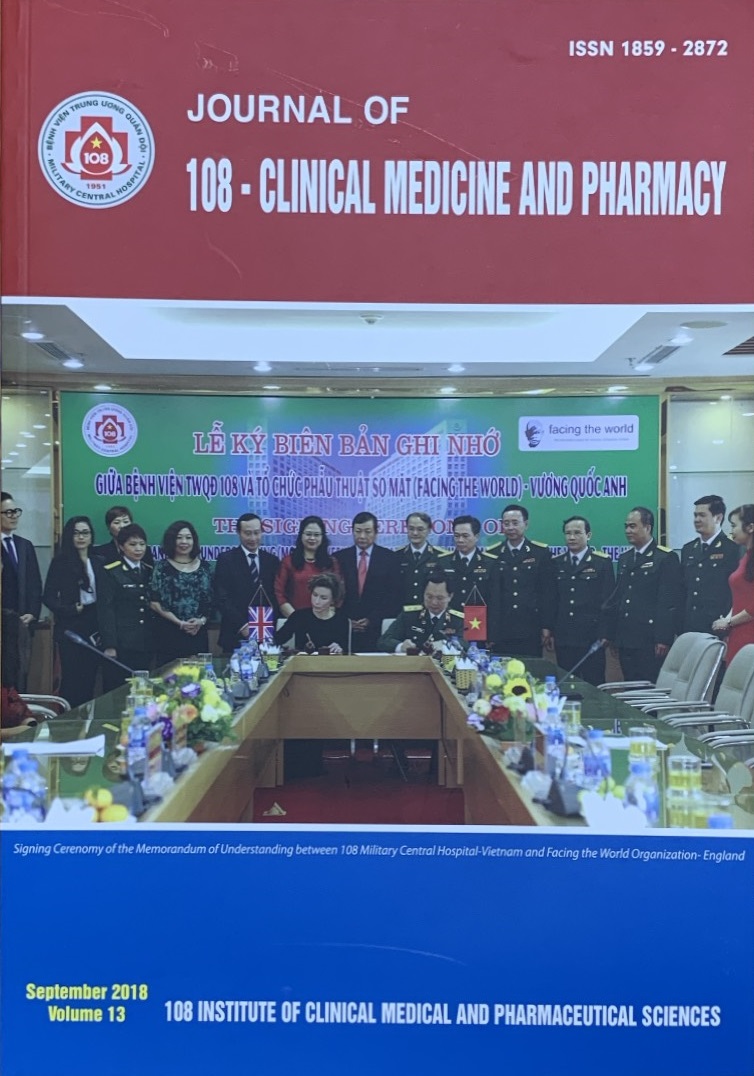¬¬¬¬Result of distal medial tibial locking plate osteosynthe-sis in treatment for distal metaphyseal tibial fractures
Main Article Content
Abstract
Objective: Minimally invasive percutaneous plate osteosynthesis (MIPPO) technique has now become more popular with the development of the locking plate. This study aimed to assess the outcomes of the using MIPPO technique with the medial distal tibial locking plate in treatment of the distal metaphyseal tibial fractures. Subject and method: Between April 2013 and December 2016, 70 patients (male/female: 53/17) of mean age 44 years (range 19 - 74) underwent MIPPO for metaphyseal tibial fractures using medial distal tibial locking plate (Intercus, Germany). Seventy fractures included 59 closed and 11 open (Gustilo classification, grade I: 4 cases, grade II: 7 cases). The main outcome measurements of this prospetive observational study are the wound healing, alignment, full weight bearing time, function and complications. Result: Sixty three cases were primary osteosynthesis, 7 cases were temporary fixed with external fixators before changed by locking plate. All the wounds of the MIPPO surgery primary healed, just one fibular plating wound was deeply infected. No case was varus, valgus or rotation > 5°. All of 70 tibial fractures were firm union without secondary displacement. The average time back to walk without crutche was 12.5 weeks. The mean AOFAS score was 85 at a mean of 15 months follow-up. Conclusion: Using medial distal tibial locking plate with MIPPO technique in treatment for the distal metaphyseal tibial fracture is safe and effective. This technique decreases the incidence of complications and can help patients to resume their function early.
Keywords: Distal tibial fracture, locking plate, MIPPO.
Article Details
References
2. Cheng W, Li Y, Manyi W (2011) Comparison study of two surgical options for distal tibia fracture-minimally invasive plate osteosynthe-sis vs. open reduction and internal fixation. Int Orthop 35(5): 737-742.
3. Bhat AK, Rao SK, Bhaskaranand K (2006) Me-chanical failur in intramedullary interlocking nails. Journal of Orthopaedic Surgery 14(2): 138-141.
4. Collinge CA, Sanders RW (2000) Percutane-ous plating in the lower extremity. Journal of the American Academy of Orthopaedic Sur-geons 8(4): 211-216.
5. Gautier E, Sommer C (2003) Guidelines for the clinical application of the LCP. Injury 34(2): 63-76.
6. Kubiak EN et al (2006) The evolution of locked plates. The Journal of Bone and Joint Surgery, 88(4): 189-200.¬¬
7. Cantu RV, Koval KJ (2006) The use of locking plates in fracture care. Journal of the American Academy of Orthopaedic Surgeons 14(3): 183-190.
8. Helfet DL, Shonnard PY, Levine D, Borrelli J (1997) Minimal invasive plate osteosynthesis of distal fractures of the Tibia. Injury, 28 Suppl. 1(A): 42-47.
9. Hasenboehler E, Rokli D, Babst R (2007) Locking compression plate with minimally in-vasive plate osteosynthesis in diaphyseal and distal tibial fracture: A retrospective study of 32 patients. Injury 38: 365-370.
10. Hazarika S et al (2006) Minimally invasive lock-ing plate osteosynthesis for fractures of the distal tibia - Results in 20 patients. Injury 37: 877-887.
11. Borrelli JJr, Prickett W, Song E, Becker D, Ric-ci W (2002) Extraosseous blood supply of the tibia and the effects of different plating tech-niques: A human cadaveric study. J Orthop Trauma 16(10): 691-695.
12. Bahari S, Lenehan B, Khan H, McElwain JP (2007) Minimally invasive percutaneous plate fixation of distal tibia fractures. Acta Orthop Belg 73: 635-640.
13. Paluvadi SV, Lal H, Mittal D, Vidyarthi K (2014) Management of fractures of the distal third tib-ia by minimally invasive plate osteosynthesis - A prospective series of 50 patients. J Orthop Trauma 5: 129-136.
14. Egol KA, Kubiak EN (2004) Biomechanics of locking plates and screws. J Orthop Trauma 18: 488-493.
15. Lai TC, Fleming JJ (2017) Minimally invasive plates osteosynthesis for distal tibia fractures. Clin Podiatr Med Surg (Article in press): 1-10.
 ISSN: 1859 - 2872
ISSN: 1859 - 2872
